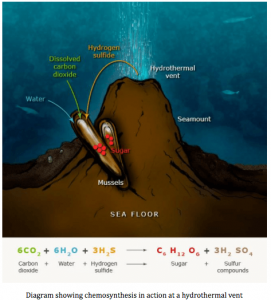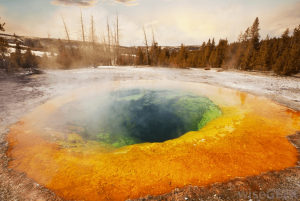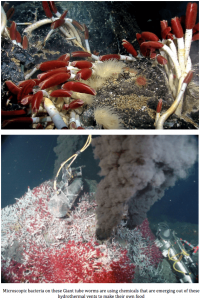Chemosynthesis is an important process that some organisms use to get energy for the production of food. This process is similar to photosynthesis, but unlike photosynthesis, chemosynthesis does not use sunlight. Instead, this energy comes from the reaction of inorganic chemicals that many of these organisms find in their environment.

(Image Credit: teara.govt.nz)
This process mostly occurs in bacteria. Many of these bacteria live in extreme conditions and are the essential building blocks of diverse ecosystems. Some of these environments where chemosynthesis can take place include the intestines of mammals, hot springs, petroleum deposits, and hydrothermal vents deep on the ocean floor.

A hot spring above showing different coloration due to chemosynthetic bacteria
(Image Credit: wisegeek.org)
There are many different organisms that rely on chemosynthesis to survive. So how exactly does this process work? Let’s take a journey into one of the most undiscovered places on our planet, hydrothermal vents. Miles deep into the bottom of our earth’s oceans live a species of animal known as giant tubeworms. On top of these giant tubeworms live chemosynthetic bacteria. These bacteria use chemicals that spring out of nearby hydrothermal vents in order to make their own food. The sulfides and hot water (which can reach temperatures of up to 212 degrees Fahrenheit) that come out of the hydrothermal vent combines with carbon dioxide in order for these bacteria to survive in such a harsh environment.

(Image Credit: NOAA & memim.com)
What’s even crazier is that some scientists believe that chemosynthetic bacteria are the first life forms to have called planet Earth home!
[Reference: http://www.wisegeek.org/what-is-chemosynthesis.htm]


